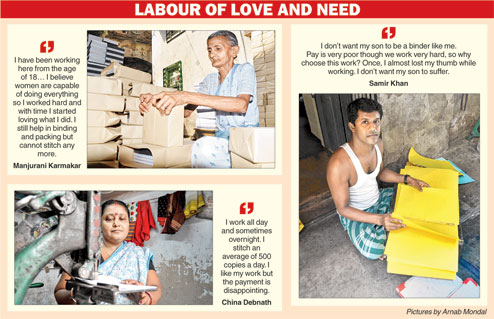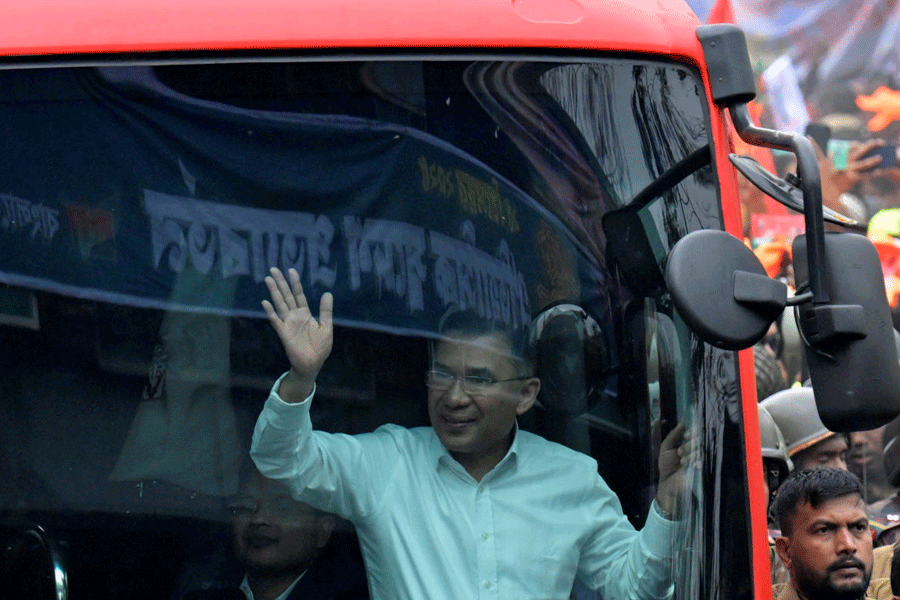 |
Samir Khan, 28, spends most of his time with law books in a dark and dingy room in a narrow lane off College Street. The boy who once dreamt of becoming a lawyer now makes a living from binding law books, hoping for freedom from the drudgery some day.
Manjurani Karmakar, 80, still remembers the day she was taken to a binder’s shop as a shy 18-year-old looking for a job. She can’t remember when she fell in love with her work but today she can’t think of a day without binding books.
Daftaripara in Ward 36 of Calcutta Municipal Corporation is home to a 200-year-old book-binding industry. Business has been on the decline since the mid-90s with advance in technology and most binders now survive on making envelopes, visiting cards and even cardboard boxes for sweets.
A group of around 15 students from the School of Media, Communication and Culture are working on a project on the rise and fall of Daftaripara. The young researchers are busy putting together a collage of videos, stills and audio clippings from life in Daftaripara for a website, which is likely to be launched next month. The website will also include statistics, transcriptions and interviews of owners, labourers, union leaders as well as experts to shed light on the crisis within the industry.
“The book-binding industry has been in existence in the city for more than 200 years but not many people have worked on it. One can find very little research on Daftaripara,” said Afsar Ahmed, a writer who assisted Ashoke Sen, former professor of Centre for Studies in Social Sciences, in research for the website.
“It was during Partition that Daftaripara started thriving. Proximity to Sealdah brought a flood of refugees in search of work. Partition gave the industry many unskilled labourers,” Afsar said, adding that Daftaripara is now plagued by a host of problems from conflict between publishers and workers and advent of ruling and offset machines that have reduced the need for manual labour.
“Certain skills like stitching and binding with leather or cloth have become rare. Ruling is another precision skill that is dying. Earlier, labourers would draw the rules manually, now ruling machines do it,” said Kaushik Mukherjee, who was closely involved with the project.
Employers complain of loss in business, while the workers rue poor pay. “Competition has increased after companies have ventured into the market and new machines have the capability of binding books without manual help,” said Samir, a third-generation binder who does not want his son to join this profession. “I don’t want my son to be a binder like me. Pay is very poor though we work very hard, so why choose this work? Once, I almost lost my thumb while working. I don’t want my son to suffer.”
When Sibu Goldar started off as a binder more than three decades ago, he earned Rs 700 a month. Today, his monthly wage of Rs 3,600 makes him among the highest paid. The average pay can be as little as Rs 50 a day or even less.
China Debnath leaves home at five every morning for work and takes the last train at 10pm. “The monthly train fare has increased from 14 anna to Rs 1,000 but my wage is hardly enough to run my family,” said China. “I work all day and sometimes overnight. I stitch an average of 500 copies a day. I like my work but the payment is disappointing.” China gets around Rs 70 per day, but the amount varies depending on the amount of work done on a particular day.
Yet, octogenarian Manju does not want to retire. “I have been working here from the age of 18. I distinctly remember coming here with a distant relative. He had promised me work. It was tough to live so far in an unknown world but I believe women are capable of doing everything so I worked hard and with time I started loving what I did,” said the lady in a white sari with a wrinkled face who earns around Rs 50 per day. “I still help in binding and packing but cannot stitch any more.”
It is the likes of Manju who have kept Daftaripara alive. “We chose Daftaripara because we wanted to do a project on something that has not been captured by the mainstream media,” said Nilanjana Guha, principal investigator of the project.
“Working on Daftaripara has been a learning process for the students and it will be help in future research too,” said Abhijit Roy, associate professor of department of film studies, who looks after the day-to-day affairs of the project. “Our aim is to create an archive where we will keep exploring and uploading things about Daftaripara and also invite critical comments.”
It has been a learning experience for the students as well. “I had no idea about the existence of Daftaripara before we took up this project. When I went for the first field visit, I was surprised at the unity of workers and owners. The class division is blurred here,” said Mukulika Dattagupta, a Phd student at Jadavpur University.











